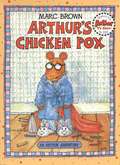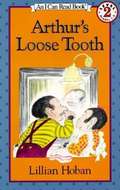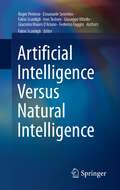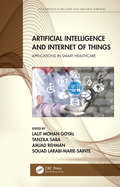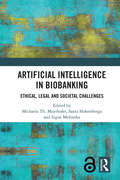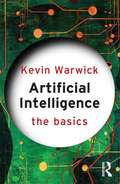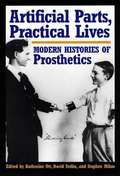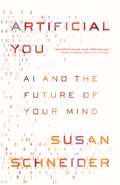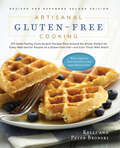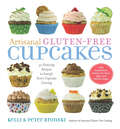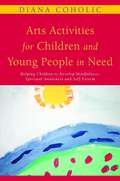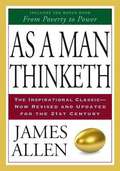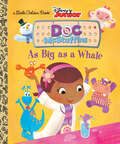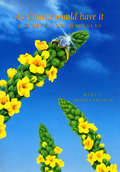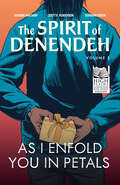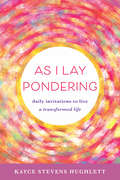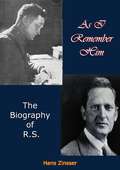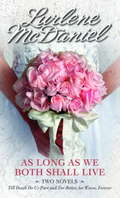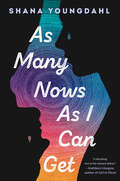- Table View
- List View
Arthur's Chicken Pox
by Marc BrownThis adventure revolves around whether or not Arthur will get over his chicken pox in time to go to the circus with his family. In the meantime, D.W. makes her own plans to invite a friend to go as Arthur's replacement and feigns chicken pox herself in a bid for attention from her family. At the end of the story, in a nod to justice, Arthur recovers in time, but D.W. comes down with spots on the morning of the circus.
Arthur's Loose Tooth (I Can Read! #Level 2)
by Lillian HobanEmergent readers will identify with Arthur, the young chimpanzee who is the star of the classic series, as he loses a tooth, finally parts with his beloved Honey Bear, and goes on a campout.
Artificial Intelligence Versus Natural Intelligence
by Roger Penrose Emanuele Severino Ines Testoni Fabio Scardigli Giuseppe Vitiello Federico Faggin Giacomo Mauro D'ArianoThis book centers around a dialogue between Roger Penrose and Emanuele Severino about one of most intriguing topics of our times, the comparison of artificial intelligence and natural intelligence, as well as its extension to the notions of human and machine consciousness.Additional insightful essays by Mauro D'Ariano, Federico Faggin, Ines Testoni, Giuseppe Vitiello and an introduction of Fabio Scardigli complete the book and illuminate different aspects of the debate. Although from completely different points of view, all the authors seem to converge on the idea that it is almost impossible to have real "intelligence" without a form of "consciousness". In fact, consciousness, often conceived as an enigmatic "mirror" of reality (but is it really a mirror?), is a phenomenon under intense investigation by science and technology, particularly in recent decades. Where does this phenomenon originate from (in humans, and perhaps also in animals)? Is it reproducible on some "device"? Do we have a theory of consciousness today? Will we arrive to build thinking or conscious machines, as machine learning, or cognitive computing, seem to promise? These questions and other related issues are discussed in the pages of this work, which provides stimulating reading to both specialists and general readers.The Chapter "Hard Problem and Free Will: An Information-Theoretical Approach" is available open access under a Creative Commons Attribution 4.0 International License via link.springer.com.
Artificial Intelligence and Internet of Things: Applications in Smart Healthcare (Innovations in Big Data and Machine Learning)
by Lalit Mohan GoyalThis book reveals the applications of AI and IoT in smart healthcare and medical systems. It provides core principles, algorithms, protocols, emerging trends, security problems, and the latest e-healthcare services findings.The book also provides case studies and discusses how AI and IoT applications such as wireless devices, sensors, and deep learning could play a major role in assisting patients, doctors, and pharmaceutical staff. It focuses on how to use AI and IoT to keep patients safe and healthy and, at the same time, empower physicians to deliver superlative care.This book is written for researchers and practitioners working in the information technology, computer science, and medical equipment manufacturing industry for products and services having basic- and high-level AI and IoT applications. The book is also a useful guide for academic researchers and students.
Artificial Intelligence in Biobanking: Ethical, Legal and Societal Challenges
by Santa Slokenberga Michaela Th. Mayrhofer Signe MežinskaThis insightful collection highlights the ethical, legal and societal issues associated with the increasing role played by artificial intelligence (AI) in medical biobanks, a key research resource in the global study of disease prevention and improving individual care.Although AI has the potential to speed up health research, the book considers numerous questions that the technology poses, from the building of trust to the prevention of harm to individuals, vulnerable groups or entire populations. Examining the tension between scientific progress and safeguarding of individual rights, and covering key issues such as accountability, data bias, transparency, and liability, the book considers the legal landscape in which biobanks operate, and what layers of governance are required to oversee such an important resource in a fluid technological age.A timely volume that brings together scholars and experts from social sciences, ethics, and law, this important book will interest researchers and professionals in Biomedicine, Law, and the broader Health Sciences.The Open Access version of this book, available at http://www.taylorfrancis.com, has been made available under a Creative Commons Attribution CC BY 4.0 license.
Artificial Intelligence: The Basics (The Basics)
by Kevin Warwick'if AI is outside your field, or you know something of the subject and would like to know more then Artificial Intelligence: The Basics is a brilliant primer.' - Nick Smith, Engineering and Technology Magazine November 2011 Artificial Intelligence: The Basics is a concise and cutting-edge introduction to the fast moving world of AI. The author Kevin Warwick, a pioneer in the field, examines issues of what it means to be man or machine and looks at advances in robotics which have blurred the boundaries. Topics covered include: how intelligence can be defined whether machines can 'think' sensory input in machine systems the nature of consciousness the controversial culturing of human neurons. Exploring issues at the heart of the subject, this book is suitable for anyone interested in AI, and provides an illuminating and accessible introduction to this fascinating subject.
Artificial Parts, Practical Lives: Modern Histories of Prosthetics
by Katherine Ott David Serlin Stephen MihmThese essays are valuable first forays into the history of prosthetics. From the wooden teeth of George Washington to the Bly prosthesis, popular in the 1860s and boasting easy uniform motions of the limb, to today's lifelike approximations, prosthetic devices reveal the extent to which the evolution and design of technologies of the body are intertwined with both the practical and subjective needs of human beings. The peculiar history of prosthetic devices sheds light on the relationship between technological change and the civilizing process of modernity, and analyzes the concrete materials of prosthetics which carry with them ideologies of body, ideals, body politics, and culture. Simultaneously critiquing, historicizing, and theorizing prosthetics, Artificial Parts, Practical Lives lays out a balanced and complex picture of its subject, neither vilifying nor celebrating the merger of flesh and machine.
Artificial You: AI and the Future of Your Mind
by Susan SchneiderA sober-minded philosophical exploration of what AI can and cannot achieveHumans may not be Earth’s most intelligent beings for much longer: the world champions of chess, Go, and Jeopardy! are now all AIs. Given the rapid pace of progress in AI, many predict that it could advance to human-level intelligence within the next several decades. From there, it could quickly outpace human intelligence. What do these developments mean for the future of the mind?In Artificial You, Susan Schneider says that it is inevitable that AI will take intelligence in new directions, but urges that it is up to us to carve out a sensible path forward. As AI technology turns inward, reshaping the brain, as well as outward, potentially creating machine minds, it is crucial to beware. Homo sapiens, as mind designers, will be playing with "tools" they do not understand how to use: the self, the mind, and consciousness. Schneider argues that an insufficient grasp of the nature of these entities could undermine the use of AI and brain enhancement technology, bringing about the demise or suffering of conscious beings. To flourish, we must grasp the philosophical issues lying beneath the algorithms.At the heart of her exploration is a sober-minded discussion of what AI can truly achieve: Can robots really be conscious? Can we merge with AI, as tech leaders like Elon Musk and Ray Kurzweil suggest? Is the mind just a program? Examining these thorny issues, Schneider proposes ways we can test for machine consciousness, questions whether consciousness is an unavoidable byproduct of sophisticated intelligence, and considers the overall dangers of creating machine minds.
Artisan Sourdough: Wholesome Recipes, Organic Grains
by Casper Andre Lugg Ivar Hveem FjeldMaster the art of sourdough, from creating a starter to baking and serving delicious loaves in this full-color, step-by-step, illustrated guide.For a growing number of people, eating heathy is more important than ever. We’re rejecting processed, packaged foods filled with unpronounceable chemicals, and are embracing, organic whole foods, including whole grain and slow made breads like sourdough—the oldest method of bread baking.In Artisan Sourdough, bakers Casper Andre Lugg and Marin Ivar Hveem Fjeld show you how to master this traditional style of bread which has never been more relevant or popular. This how-to book features fifteen no-fail recipes with clear, step-by-step instructions and photographs to help you make your own artisanal loaves at home.The methods and recipes in Artisan Sourdough continue a tradition that is more than 5,000 years old: mix flour and water, then allow the dough to ferment and rise by itself. This extended fermentation process allows for maximum flavor—and easier digestion. With an emphasis on local, heirloom, and ancient grains, the authors introduce the natural ingredients used in artisan baking, teaching how to make a stable starter, and explaining how to “set the leaven” to create perfect baked loaves. The book comes complete with cook’s notes and a trouble-shooting section to help you to avoid soggy bottoms, over baking, and other common problems.This is an indispensable resource for bakers, the perfect starter guide for the beginner bread baker that demystifies this traditional food that has been enjoyed around the world for generations.
Artisanal Gluten-Free Cooking, Second Edition: 275 Great-tasting, From-scratch Recipes From Around The World, Perfect For Every Meal And For Anyone On A Gluten-free Diet--and Even Those Who Aren't (No Gluten, No Problem #0)
by Peter Bronski Kelli BronskiAn expanded edition—now bursting with color throughout—of a category-leading gluten-free cookbook—ready to reach more home cooks than ever Since its original publication in 2009, Artisanal Gluten-Free Cooking has steadily grown in popularity as more and more home cooks have embraced Kelli and Peter Bronski’s high-quality gluten-free recipes for every meal, from breakfast through dessert. Now, in an extensively revised and expanded second edition, this trusted, versatile cookbook is better than ever. Here are: • 25 brand-new recipes and nearly 100 additional pages • 50 all-new full-page color photographs • The quality ingredients, from-scratch preparation methods, and unbeatable flavors that made the original edition so appealing • Dozens of recipes, from bagels to birthday cake, perfectly suited to the Bronskis’ signature all-purpose flour blend—including Belgian Waffles, Sandwich Bread, pizzas and pastas galore, Cannoli, Carrot Cake, Blueberry Pie, cookies, and much more • Globally inspired dishes, from Italian to Indian to Mexican and beyond—such as Tortellini, General Chang’s Chicken, and Pork Tamales • An expanded array of vegetarian options such as Quinoa Salad, Brussels Sprouts-Tofu Fried Rice, and Red Lentil Dal • A thorough introduction to gluten-free shopping and cooking—plus handy tips about ingredients, equipment, and techniques sprinkled throughout.
Artisanal Gluten-Free Cupcakes: 50 Enticing Recipes To Satisfy Every Cupcake Craving (No Gluten, No Problem #0)
by Peter Bronski Kelli BronskiFrom simple to spectacular—50 enticing recipes to satisfy every cupcake craving! The wait for an entire cookbook of gluten-free cupcakes is over! Kelli and Peter Bronski’s Artisanal Gluten-Free Cooking garnered a PW starred review and airtime on The Splendid Table, and within one year of publication has established itself as a category-leading all-purpose gluten-free cookbook. Now the Bronskis bring their accessible but “artisanal” approach to these from-scratch, high-quality homemade cupcakes. The foundation of these recipes is their intensively developed gluten-free flour blend, which enables home cooks to craft bakery-quality confections, from kid-pleasing favorites like Vanilla Cupcakes with Chocolate Frosting or “Peanut Butter Cup” Cakes, to more subtle and surprising treats like Mojito or Poached Pearfection cupcakes. They include tips for adapting the recipes to alternative diets of all kinds, including egg-, dairy-, and refined sugar–free versions. These are cupcakes so good even those who don’t eat gluten-free will love them.
Arts Activities for Children and Young People in Need
by Diana CoholicArt-based activities can develop resilience and self-esteem, enabling children in need to cope better with ongoing stress and loss. Arts Activities for Children and Young People in Need offers interventions and exercises drawn from practice and research, for practitioners to use as a basis for their own arts-based groups or one-to-one sessions. Holistic arts activities facilitate a spiritually sensitive approach. Mindfulness-based exercises underpin the approach, and include guided meditations in which a group imagines that they are clouds, or draw feelings and emotions while listening to music, to encourage awareness of the senses. The activities help the group to relax and become more self-aware, encourage an exploration of feelings, values and understanding and are beneficial for children not ready to embrace traditional therapies or counselling. This book is accessible and suitable for helping, health and education practitioners and students from a variety of disciplines, such as social work, psychology and counselling.
As A Man Thinketh
by James AllenThe mind guides our footsteps as we progress along the pathway of life.<P> Purity of mind leads inevitably to purity of life, to the precious love and understanding that should control our everyday acts and attitudes towards friends and foes.<P> But where must one look for guidance? How does one achieve purity of mind that alone brings happiness and confidence?<P> The author offers his clear answers in this book As A Man Thinketh. His words have helped millions for more than a century--and they continue to point the true way to a better life for a troubled humanity.<P> "Out of a clean heart comes a clean life and a clean body," James Allen writes. "out of a defiled mind proceeds a defiled life and a corrupt body."<P> Too many mortals strive to improve only their wordly position--and too few seek spiritual betterment. Such is the problem James Allen faced in his own time. The ideas he found in his inner-most heart after great searching guided him as they will guide you.
As Big as a Whale (Little Golden Book)
by Andrea Posner-SanchezDoc McStuffins gets a little beluga whale toy named Lulu who can grow in water. The problem is, Lulu wants to be big now! Growing boys and girls ages 2 to 5 will love this Little Golden Book retelling an episode from the popular Disney Junior series Doc McStuffins. And they'll also love finding out Doc's secret to getting bigger—patience!
As Chance Would Have It: A Study in Coincidences
by H C MoolenburghCoincidences happen to everyone on a regular basis. Usually we shrug them off and forget them.However, when we start to catalogue coincidences we are in for a surprise. They begin to grow more frequent and, moreover, they tend to form a pattern as if conveying a secret message.
As I Enfold You in Petals (The Spirit of Denendeh)
by Richard Van CampNewly sober, Curtis searches for healing in the ancient cultural practices of his Tłıcho Dene grandfather. But will the Little People answer his call?Curtis has returned to Fort Smith, six weeks sober. He doesn&’t have any sober friends, his mom&’s still drinking, and his best friend (and secret crush) Lacey probably is too. Still, he&’s determined to abstain from alcohol and help his people. Along the way, he might just be able to help himself.Louis, Curtis&’s late grandfather, was a healer. Legend has it, Louis made a deal with the Little People that gave him the power to heal. No one has heard from the Little People since Louis&’s death, but his cabin may hold the key for them to return. There&’s only one problem: Benny the Bank stands in the way.An infamous bootlegger, Benny has profited off Fort Smith&’s pain for decades. After being critically wounded in an attempt on his life, Benny knows he doesn&’t have much time before the poison in his blood takes him. He also happens to own Louis&’s cabin.Can Curtis convince Benny to return the home that once belonged to Louis? Will the Little People answer Curtis&’s call? And can Benny find a way to make amends and leave a legacy he can be proud of?A stunning, fast-paced graphic novel, As I Enfold You in Petals will keep readers riveted until the last page.
As I Enfold You in Petals (The Spirit of Denendeh)
by Richard Van CampNewly sober, Curtis searches for healing in the ancient cultural practices of his Tłıcho Dene grandfather. But will the Little People answer his call?Curtis has returned to Fort Smith, six weeks sober. He doesn&’t have any sober friends, his mom&’s still drinking, and his best friend (and secret crush) Lacey probably is too. Still, he&’s determined to abstain from alcohol and help his people. Along the way, he might just be able to help himself.Louis, Curtis&’s late grandfather, was a healer. Legend has it, Louis made a deal with the Little People that gave him the power to heal. No one has heard from the Little People since Louis&’s death, but his cabin may hold the key for them to return. There&’s only one problem: Benny the Bank stands in the way.An infamous bootlegger, Benny has profited off Fort Smith&’s pain for decades. After being critically wounded in an attempt on his life, Benny knows he doesn&’t have much time before the poison in his blood takes him. He also happens to own Louis&’s cabin.Can Curtis convince Benny to return the home that once belonged to Louis? Will the Little People answer Curtis&’s call? And can Benny find a way to make amends and leave a legacy he can be proud of?A stunning, fast-paced graphic novel, As I Enfold You in Petals will keep readers riveted until the last page.
As I Enfold You in Petals (The Spirit of Denendeh)
by Richard Van CampNewly sober, Curtis searches for healing in the ancient cultural practices of his Tłıcho Dene grandfather. But will the Little People answer his call?Curtis has returned to Fort Smith, six weeks sober. He doesn&’t have any sober friends, his mom&’s still drinking, and his best friend (and secret crush) Lacey probably is too. Still, he&’s determined to abstain from alcohol and help his people. Along the way, he might just be able to help himself.Louis, Curtis&’s late grandfather, was a healer. Legend has it, Louis made a deal with the Little People that gave him the power to heal. No one has heard from the Little People since Louis&’s death, but his cabin may hold the key for them to return. There&’s only one problem: Benny the Bank stands in the way.An infamous bootlegger, Benny has profited off Fort Smith&’s pain for decades. After being critically wounded in an attempt on his life, Benny knows he doesn&’t have much time before the poison in his blood takes him. He also happens to own Louis&’s cabin.Can Curtis convince Benny to return the home that once belonged to Louis? Will the Little People answer Curtis&’s call? And can Benny find a way to make amends and leave a legacy he can be proud of?A stunning, fast-paced graphic novel, As I Enfold You in Petals will keep readers riveted until the last page.
As I Lay Pondering: Daily Invitations To Live A Transformed Life
by Kayce Stevens HughlettPsychotherapist, healer, and artist of being alive, Kayce Stevens Hughlett, offers readers the personal gift of transformation in this devotional daybook. Like Mark Neop's classic "Book of Awakening," Hughlett invites individuals to enliven their lives day-by-day through 365 practical reflections and prayers of inspiration, purpose, freedom, and joy. <p><p> Infused with teachings from historical and current wisdom figures like Carl Jung, Martha Beck, Buddha, Jesus, Lao Tzu, Thomas Merton, Sue Monk Kidd, Anne Lamott, and others, "As I Lay Pondersing" feels like sitting down for conversation with a close friend. Filled with soul, it will meet you where you are whether looking for a recharge or grasping for a lifeline. It is a book you can turn to anytime and read cover to cover, randomly, or one entry at a time. Filled with inspiration, short stories, and simple activities to deepen the pathway to presence, this book is the ideal companion for any personal journey.
As I Live and Breathe: Notes of a Patient-Doctor
by Jamie WeismanFrom the Publisher: Jamie Weisman was a patient long before she was a doctor. She was born with a rare defect in her immune system that leaves her prey to a range of ailments and crises and that, because it is treatable but not curable, will keep her a patient for life. Her history has graced her with a deeper perspective -- a second sight, in a sense -- on the body itself, in all its frailty, glory, and irreducible mystery. In this probing and inspiring book, Weisman brings her sojourns on both sides of the doctor-patient divide to bear on the issues of the flesh that preoccupy us all. She considers the randomness of illness, and the fears and fortitude it calls forth in those it strikes. She weighs the economic and moral value of sustaining any given life. She explores the vulnerabilities of the body and of those who care for it, including their capacity for error. And she conveys, by eloquent example, that the only cure for the fear of death is living. As I Live and Breathe is a view of medicine from both sides of the trenches, embracing the patient's fervent desire for health and the doctor's fervent desire to grant it. It is a worthy addition to the best that has been written about our physical selves, a meditation on our extraordinary powers of healing and the limitations that leave intact the miracle and tragedy of being.
As I Remember Him: The Biography of R.S.
by Hans ZinsserTHIS remarkable book is a legacy to his generation from a great doctor, great scientist, great talker, and a complete human being. Dr. Hans Zinsser of the Harvard Medical School, and author of that fascinating book, Rats, Lice and History, has set down, under the transparent fiction of a biography of R. S., the best remembered personal experiences of his life—his best stories, his best thoughts, his matured reflections on life and how it behaves, from obstetrics to education and research and war. And he has written his book as he talks to his students (who regard him as their best lecturer) and to his friends. For this is a man of many friends, and of an insatiable zest for experience.And what a life! Recent books have shown us how interesting the life of a country doctor can be. But this man, Zinsser, went on through the amusing, pathetic, tragic experiences of an ambulance doctor to the wider field of research in bacteriology. And his success there carried him afield as an expert, to typhus camps in Serbia, to China, to Persia, to Mexico in search of rats, to Japan. And he carried with him, in addition to his research equipment, one of those liberal, observant minds, well-stocked with education, humorous, reflective, optimistic, which takes as much as it gives, and stores it away to ripen. This book is not only his autobiography, it is also the book of a modern Boswell reporting his times and ours.
As Kinky as You Wanna Be: Your Guide to Safe, Sane and Smart BDSM
by Shanna GermainAs Kinky as You Wanna Be is not an instruction book. It won't teach you how to tie up your squirming lover or choose the proper lube.Rather, it teaches you how to be a kinky person who has safe, sane, and smart experiences. Like a tourist's guide to BDSM, As Kinky as You Wanna Be offers a road map to your own kinky self. This book helps you discover which kinky countries you want to visit, gives you tips and techniques on the language of BDSM, and helps you navigate the customs and rituals of the kink community.With sections on discovering your pleasures; talking about kink with your partner, your family, or your doctor; staying physically and mentally safe; putting your kinky dreams into practice; and dealing with difficult situations, As Kinky as You Wanna Be is your guide and confidant. The book features informative interviews with BDSM experts such as Jay Wiseman and Lee Harrington, and it is sprinkled with stories from top erotica authors like Janine Ashbless and Rachel Kramer Bussel.Whether your first kinky experience or thousandth, As Kinky as You Wanna Be guides you — safely and smartly.
As Long as I Live: The Life Story of Aharon Margalit
by Moshe Gutman Sharon GelbachAs Long As I Live will give hope to every reader. It is about Aharon Margalit, a man who fights cancer three times and yet views his living in a positive way.
As Long as We Both Shall Live: Two NOvels
by Lurlene McdanielA change is coming, April Lancaster's fortune cookie reads. Be prepared. But how could she be prepared for the news that she has an inoperable brain tumor? April's life will never be the same. Then she meets handsome Mark Gianni. Mark has cystic fibrosis, but he also has a passion for life . . . and for April. When he asks April to marry him, she's happier than she's ever been.April thought she and Mark would be together forever. But since Mark's death, April has never felt more alone. Then Brandon Benedict comes into her life. Brandon is lonely and angry--he and April have a lot in common. But April cannot tell Brandon about her illness. When April's medical problems suddenly return, she must decide what to tell Brandon. Can the love she's felt before help her now?From the Paperback edition.
As Many Nows as I Can Get
by Shana YoungdahlA Seventeen Best Book of the YearA New York Public Library Top Ten Best Book of the YearA Kirkus Best Book of the YearFor fans of All the Bright Places, Looking for Alaska, and I'll Give You the Sun comes "a daring, inventive story about love and loss and longing, reminding us that every choice can be a new chance. A dazzling, not-to-be-missed debut." —Kathleen Glasgow, author of Girl in PiecesIn one impulsive moment the summer before they leave for college, overachievers Scarlett and David plunge into an irresistible swirl of romance, particle physics, and questionable decisions. Moving between the present and the past, this is the story of a grounded girl who's pulled into a lightning-strike romance with an electric-charged boy, and the enormity of the aftermath.Scarlett and David have known each other all their lives in small-town Colorado, where David is just another mountain in the background, until, one day, he is suddenly so much more than part of the scenery. David is magnetic, spontaneous, a gravitational force. And Scarlett, pragmatic, wry, eye on the future, welcomes the pull he has on her even as she resists it. Drawn to his wild energy, to the relief she feels in throwing off the weight of everyone&’s expectations, Scarlett still can&’t ignore the tug of her own hopes and ambitions, while David struggles between his feelings for her, which might be deeper than either of them will admit, and his own destructive impulses.Heartbreaking, hopeful, and unflinchingly honest, this is a deeply moving account of a girl dealing with grief and guilt, and learning to reconcile who she thinks she needs to be with the person she&’s been all along. It&’s an aching, transporting reminder that between the past that shapes us and the future ahead, we have only the present to forgive ourselves and forge ahead."Deeply authentic . . . Marvelously complex . . . Readers shouldn't miss [it]" —Kirkus (starred review)"Mystery . . . Heartbreak . . . Hope . . . Readers will not be able to put this one down." —SLJ"Vivid" —Seventeen.com"You'll speed read through [it]" —PopSugar"John Green-like, intelligent and peppered with witty repartee" —Booklist"A story you won't forget." —Huntley Fitzpatrick, author of My Life Next Door"Heartbreaking, exquisitely crafted" —Estelle Laure, author of This Raging Light"A complex, compassionately written love story" —PW"A definite purchase and must read." —VOYA
